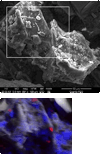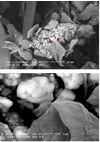Identifying transfer mechanisms and sources of decabromodiphenyl ether (BDE 209) in indoor environments using environmental forensic microscopy
- PMID: 19534115
- PMCID: PMC2722073
- DOI: 10.1021/es803139w
Identifying transfer mechanisms and sources of decabromodiphenyl ether (BDE 209) in indoor environments using environmental forensic microscopy
Abstract
Although the presence of polybrominated diphenyl ethers (PBDEs) in house dust has been linked to consumer products, the mechanism of transfer remains poorly understood. We conjecture that volatilized PBDEs will be associated with dust particles containing organic matter and will be homogeneously distributed in house dust. In contrast, PBDEs arising from weathering or abrasion of polymers should remain bound to particles of the original polymer matrix and will be heterogeneously distributed within the dust. We used scanning electron microscopy and othertools of environmental forensic microscopy to investigate PBDEs in dust, examining U.S. and U.K. dust samples with extremely high levels of BDE 209 (260-2600 microg/g), a nonvolatile compound at room temperature. We found that the bromine in these samples was concentrated in widely scattered, highly contaminated particles. In the house dust samples from Boston (U.S.), bromine was associated with a polymer/organic matrix. These results suggest that the BDE 209 was transferred to dust via physical processes such as abrasion or weathering. In conjunction with more traditional tools of environmental chemistry, such as gas chromatography/mass spectrometry (GC/MS), environmental forensic microscopy provides novel insights into the origins of BDE 209 in dust and their mechanisms of transfer from products.
Figures







Comment in
-
CSI-style tools offer clues about flame retardants in dust.Environ Sci Technol. 2009 May 1;43(9):2998. doi: 10.1021/es900669w. Environ Sci Technol. 2009. PMID: 19534102 No abstract available.
References
-
- LaGuardia MJ, Hale RC, Harvey E. Detailed polybrominated diphenyl ether (PBDE) congener composition of the widely used penta-, octa-, and deca-PBDE technical flame-retardant mixtures. Environ. Sci. Technol. 2006;40:6247–6254. - PubMed
-
- Allen JG, McClean MD, Stapleton HM, Webster TF. Linking PBDEs in house dust to consumer products using X-ray fluorescence (XRF) Environ. Sci. Technol. 2008;42:4222–4228. - PubMed
-
- Hazrati S, Harrad S. Causes of variability in concentrations of polychlorinated biphenyls and polybrominated diphenyl ethers in indoor air. Environ. Sci. Technol. 2006;40:7584–7589. - PubMed
-
- Hale RC, La Guardia MJ, Harvey E, Mainor TM. Potential role of fire retardant-treated polyurethane foam as a source of brominated diphenyl ethers to the US environment. Chemosphere. 2002;46:729–735. - PubMed
-
- Wilford BH, Shoeib M, Harner T, Zhu J, Jones KC. Polybrominated diphenyl ethers in indoor dust in Ottawa, Canada: implications for sources and exposure. Environ. Sci. Technol. 2005;39:7027–7035. - PubMed
Publication types
MeSH terms
Substances
Grants and funding
LinkOut - more resources
Full Text Sources
Medical
Miscellaneous

